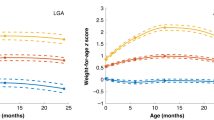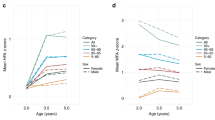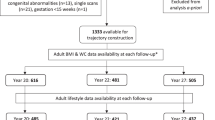Abstract
Objective:
To identify developmental trajectories of adiposity from birth until early adulthood, and to investigate how they relate with cardiometabolic risk factors at 21 years of age.
Methods:
Participants’ weight and height measurements were obtained using the EPITeen cohort protocol at 13, 17 and 21 years of age, and extracted from child health books as recorded during health routine evaluations since birth. Blood pressure, triglycerides, cholesterol and insulin resistance (HOMA-IR) were assessed at 21 years. Trajectories were defined using 719 participants contributing 11 459 measurements. The individual growth curves were modelled using mixed-effects fractional polynomial, and the trajectories were estimated using normal mixture modelling for model-based clustering. Differences in cardiometabolic risk factors at 21 years according to adiposity trajectories were estimated through analysis of covariance (ANCOVA), and adjusted means are presented.
Results:
Two trajectories—‘Average body mass index (BMI) growth’ (80.7%) and ‘Higher BMI growth’ (19.3%)—were identified. Compared with those in ‘Average BMI growth’, ‘Higher BMI growth’ participants were more frequently delivered by caesarean section, mothers were younger and had higher BMI, and parental education was lower; and at 21 years showed higher adjusted mean systolic (111.6 vs 108.3 mm Hg, P<0.001) and diastolic blood pressure (71.9 vs 68.4 mm Hg, P<0.001), and lower high-density lipoprotein cholesterol (53.3 vs 57.0 mg dl−1, P=0.001). As there was a significant interaction between trajectories and sex, triglycerides and HOMA-IR were stratified by sex and we found significantly higher triglycerides, in males, and higher HOMA-IR in both sexes in ‘Higher BMI growth’ trajectory. All the differences were attenuated after adjustment for BMI at 21 years.
Conclusions:
In this long-term follow-up, we were able to identify two adiposity trajectories, statistically related to the BMI and cardiometabolic profile in adulthood. Our results also suggest that the impact of the adiposity trajectory on cardiometabolic profile is mediated by current BMI.
This is a preview of subscription content, access via your institution
Access options
Subscribe to this journal
Receive 12 print issues and online access
$259.00 per year
only $21.58 per issue
Buy this article
- Purchase on Springer Link
- Instant access to full article PDF
Prices may be subject to local taxes which are calculated during checkout

Similar content being viewed by others
References
Wang YC, McPherson K, Marsh T, Gortmaker SL, Brown M . Health and economic burden of the projected obesity trends in the USA and the UK. Lancet 2011; 378: 815–825.
Moraeus L, Lissner L, Sjoberg A . Stable prevalence of obesity in Swedish schoolchildren from 2008 to 2013 but widening socio-economic gap in girls. Acta Paediatr 2014; 103: 1277–1284.
Ng M, Fleming T, Robinson M, Thomson B, Graetz N, Margono C et al. Global, regional, and national prevalence of overweight and obesity in children and adults during 1980-2013: a systematic analysis for the Global Burden of Disease Study 2013. Lancet 2014; 384: 766–781.
Singh AS, Mulder C, Twisk JW, van Mechelen W, Chinapaw MJ . Tracking of childhood overweight into adulthood: a systematic review of the literature. Obes Rev 2008; 9: 474–488.
Adair LS . Child and adolescent obesity: epidemiology and developmental perspectives. Physiol Behav 2008; 94: 8–16.
Reilly JJ, Kelly J . Long-term impact of overweight and obesity in childhood and adolescence on morbidity and premature mortality in adulthood: systematic review. Int J Obes (Lond) 2011; 35: 891–898.
Park MH, Falconer C, Viner RM, Kinra S . The impact of childhood obesity on morbidity and mortality in adulthood: a systematic review. Obes Rev 2012; 13: 985–1000.
Nagin DS, Odgers CL . Group-based trajectory modeling in clinical research. Annu Rev Clin Psychol 2010; 6: 109–138.
Ramos E, Barros H . Family and school determinants of overweight in 13-year-old Portuguese adolescents. Acta Paediatr 2007; 96: 281–286.
Gibson RS . Principles of Nutritional Assessment, 2nd edn. Oxford University Press: New York, 2005.
Clinical guidelines on the identification, evaluation, and treatment of overweight and obesity in adults: executive summary. Expert Panel on the Identification, Evaluation, and Treatment of Overweight in Adults. Am J Clin Nutr 1998; 68: 899–917.
Friedewald WT, Levy RI, Fredrickson DS . Estimation of the concentration of low-density lipoprotein cholesterol in plasma, without use of the preparative ultracentrifuge. Clin Chem 1972; 18: 499–502.
Matthews DR, Hosker JP, Rudenski AS, Naylor BA, Treacher DF, Turner RC . Homeostasis model assessment: insulin resistance and beta-cell function from fasting plasma glucose and insulin concentrations in man. Diabetologia 1985; 28: 412–419.
Weber MA, Schiffrin EL, White WB, Mann S, Lindholm LH, Kenerson JG et al. Clinical practice guidelines for the management of hypertension in the community a statement by the American Society of Hypertension and the International Society of Hypertension. J Hypertens 2014; 32: 3–15.
Royston P, Altman DG . Regression using fractional polynomials of continuous covariates: parsimonious parametric modelling. Appl Stat 1994; 43: 429–467.
Fraley C, Raftery AE . Model-based clustering, discriminant analysis, and density estimation. J Am Stat Assoc 2002; 97: 611–631.
Witten IH, Frank E . Data Mining: Practical Machine Learning Tools and Techniques, Second Edition (Morgan Kaufmann Series in Data Management Systems). Morgan Kaufmann Publishers Inc.: San Francisco, CA, USA, 2005.
Pinheiro J, Bates D, DebRoy S, Sarkar D . Linear and nonlinear mixed effects models. R Package Version 2007; 3: 57.
Fraley C, Raftery AE, Murphy B, Scrucca L . Mclust Version 4 for R: Normal Mixture Modeling and Model-based Clustering, Classification, and Density Estimation. Technical Report No. 597. Department of Statistics, University of Washington: Washington, 2012.
Morrissey TW . Trajectories of growth in body mass index across childhood: Associations with maternal and paternal employment. Soc Sci Med 2013; 95: 60–68.
Howe LD, Tilling K, Matijasevich A, Petherick ES, Santos AC, Fairley L et al. Linear spline multilevel models for summarising childhood growth trajectories: a guide to their application using examples from five birth cohorts. Stat Methods Med Res 2013; pii: 0962280213503925 . e-pub ahead of print 9 October 2013.
Haga C, Kondo N, Suzuki K, Sato M, Ando D, Yokomichi H et al. Developmental trajectories of body mass index among Japanese children and impact of maternal factors during pregnancy. PLoS One 2012; 7: e51896.
Ziyab AH, Karmaus W, Kurukulaaratchy RJ, Zhang H, Arshad SH . Developmental trajectories of Body Mass Index from infancy to 18 years of age: prenatal determinants and health consequences. J Epidemiol Community Health 2014; 68: 934–941.
Carter MA, Dubois L, Tremblay MS, Taljaard M, Jones BL . Trajectories of childhood weight gain: the relative importance of local environment versus individual social and early life factors. PLoS One 2012; 7: e47065.
Garden FL, Marks GB, Simpson JM, Webb KL . Body mass index (BMI) trajectories from birth to 11.5 years: relation to early life food intake. Nutrients 2012; 4: 1382–1398.
Pryor LE, Tremblay RE, Boivin M, Touchette E, Dubois L, Genolini C et al. Developmental trajectories of body mass index in early childhood and their risk factors: an 8-year longitudinal study. Arch Pediatr Adolesc Med 2011; 165: 906–912.
Nonnemaker JM, Morgan-Lopez AA, Pais JM, Finkelstein EA . Youth BMI trajectories: evidence from the NLSY97. Obesity (Silver Spring) 2009; 17: 1274–1280.
Li C, Goran MI, Kaur H, Nollen N, Ahluwalia JS . Developmental trajectories of overweight during childhood: role of early life factors. Obesity (Silver Spring) 2007; 15: 760–771.
Li HT, Zhou YB, Liu JM . The impact of cesarean section on offspring overweight and obesity: a systematic review and meta-analysis. Int J Obes (Lond) 2013; 37: 893–899.
Flemming K, Woolcott CG, Allen AC, Veugelers PJ, Kuhle S . The association between caesarean section and childhood obesity revisited: a cohort study. Arch Dis Child 2013; 98: 526–532.
Barros FC, Matijasevich A, Hallal PC, Horta BL, Barros AJ, Menezes AB et al. Cesarean section and risk of obesity in childhood, adolescence, and early adulthood: evidence from 3 Brazilian birth cohorts. Am J Clin Nutr 2012; 95: 465–470.
Huang RC, Burrows S, Mori TA, Oddy WH, Beilin LJ . Lifecourse adiposity and blood pressure between birth and 17 years old. Am J Hypertens 2015; 28: 1056–1063.
Huang RC, de Klerk NH, Smith A, Kendall GE, Landau LI, Mori TA et al. Lifecourse childhood adiposity trajectories associated with adolescent insulin resistance. Diabetes Care 2011; 34: 1019–1025.
Schisterman EF, Cole SR, Platt RW . Overadjustment bias and unnecessary adjustment in epidemiologic studies. Epidemiology 2009; 20: 488–495.
Lucas A, Fewtrell MS, Cole TJ . Fetal origins of adult disease-the hypothesis revisited. BMJ 1999; 319: 245–249.
Howe LD, Tilling K, Lawlor DA . Accuracy of height and weight data from child health records. Arch Dis Child 2009; 94: 950–954.
Acknowledgements
We gratefully acknowledge funding from the Portuguese Foundation for Science and Technology (FCOMP-01-0124-FEDER-015750, and SFRH/BD/78153/2011 to JA).
Author information
Authors and Affiliations
Corresponding author
Ethics declarations
Competing interests
The authors declare no conflict of interest.
Additional information
Supplementary Information accompanies this paper on International Journal of Obesity website
Supplementary information
Rights and permissions
About this article
Cite this article
Araújo, J., Severo, M., Barros, H. et al. Developmental trajectories of adiposity from birth until early adulthood and association with cardiometabolic risk factors. Int J Obes 39, 1443–1449 (2015). https://doi.org/10.1038/ijo.2015.128
Received:
Revised:
Accepted:
Published:
Issue Date:
DOI: https://doi.org/10.1038/ijo.2015.128
This article is cited by
-
Association between BMI trajectories from childhood to early adulthood and the carotid intima-media thickness in early adulthood: Tehran lipid and glucose study
BMC Public Health (2023)
-
Changes in sedentary behavior patterns during the transition from childhood to adolescence and their association with adiposity: a prospective study based on compositional data analysis
Archives of Public Health (2022)
-
Developmental trajectories of body mass index since childhood and health-related quality of life in young adulthood: Tehran Lipid and Glucose Study
Quality of Life Research (2022)
-
Resolving early obesity leads to a cardiometabolic profile within normal ranges at 23 years old in a two-decade prospective follow-up study
Scientific Reports (2021)
-
Maternal and infant prediction of the child BMI trajectories; studies across two generations of Northern Finland birth cohorts
International Journal of Obesity (2021)



